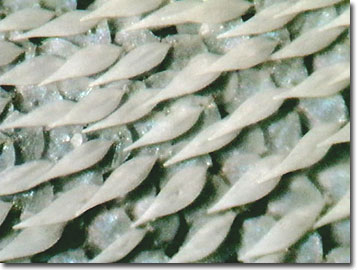Butterfly Wing Scale Digital Image Gallery
Small Apollo Butterfly
The small apollo butterfly, described by entomologists as Parnassius phoebus, is a high ranging insect that frequents small brooks and riparian corridors in the mountains of western North America, Asia, and Europe. Due to environmental constraints, the small apollo butterfly must complete an entire generation in a very short period of time, generally from late June to late August. Highly fecund, adult females may lay as many as 1,000 eggs, but few of them will make it to maturity and successfully reproduce.

Small apollo butterflies demonstrate various means of defense to increase their chances of survival. Although the species lacks the visually distracting hind wing extensions characteristic of its family, Papilionidae, the undersides of their hind wings feature pairs of false red eyespots. When threatened, the butterflies spread their wings wide to display the eyespots, make convulsive movements with their wings, and create a scratching sound by rubbing their hind legs against the undersides of the wings in hopes of deterring predation. If a predator attacks despite the defensive behavior, it may regret the decision. The body fluids of the butterfly species irritate the skin of humans and render them unpalatable to birds and other predators.
An interesting behavioral characteristic of small apollo butterflies prevents sperm competition among potential male mates. The male butterflies emerge about nine days earlier than the females and actively patrol an area in search of a mate. Soon after the females emerge, often even before they are able to fly, mating occurs. Afterwards, the male leaves a sphragis, or small white pouch, at the tip of the female's abdomen. The waxy secretion contains sperm and important nutrients, which increase the chances of successful fertilization. The sphragis also acts as a wax seal that prevents the fertilized female from mating again.
Habitat destruction associated with skiing resorts, road building, and residential developments has taken its toll on this stunning alpine butterfly species. Once damaged or destroyed, the crucial food plants of the small apollo butterfly larvae are slow to recover. In Germany's Alps, the small apollo butterfly species is listed as endangered and is protected from collection. However, subspecies from other regions are captured and reared for commercial sale to butterfly enthusiasts. Morphic and geographic variation, a brief adult lifespan, and the difficulty of capturing the adults in their mountainous terrain, make small apollo butterflies quite valuable.
Small Apollo Butterfly Images in Reflected Light
Wing Scales and Fur - Black and white wing scales highlighted by a soft layer of white fur make this an exquisite image. The reflected light lends an opalescent quality to the delicate scales.
False Red Eyespot (Low Magnification) - This low magnification image displays one of the false red eyespots located on the underside of a small apollo butterfly wing. The lepidopteran displays the markings when it feels threatened in an attempt to deter an attack.
False Red Eyespot (High Magnification) - The false red eyespot is displayed under an increased level of magnification in this photomicrograph and appears even more like a glowing red eye.
Contributing Authors
Cynthia D. Kelly, Shannon H. Neaves, Laurence D. Zuckerman, and Michael W. Davidson - National High Magnetic Field Laboratory, 1800 East Paul Dirac Dr., The Florida State University, Tallahassee, Florida, 32310.
BACK TO THE BUTTERFLY WING SCALE IMAGE GALLERY
BACK TO THE DIGITAL IMAGE GALLERIES
Questions or comments? Send us an email.
© 1995-2025 by Michael W. Davidson and The Florida State University. All Rights Reserved. No images, graphics, software, scripts, or applets may be reproduced or used in any manner without permission from the copyright holders. Use of this website means you agree to all of the Legal Terms and Conditions set forth by the owners.
This website is maintained by our
Graphics & Web Programming Team
in collaboration with Optical Microscopy at the
National High Magnetic Field Laboratory.
Last Modification Friday, Nov 13, 2015 at 01:19 PM
Access Count Since January 21, 2003: 20318
Visit the website of our partner in introductory microscopy education:
|
|
